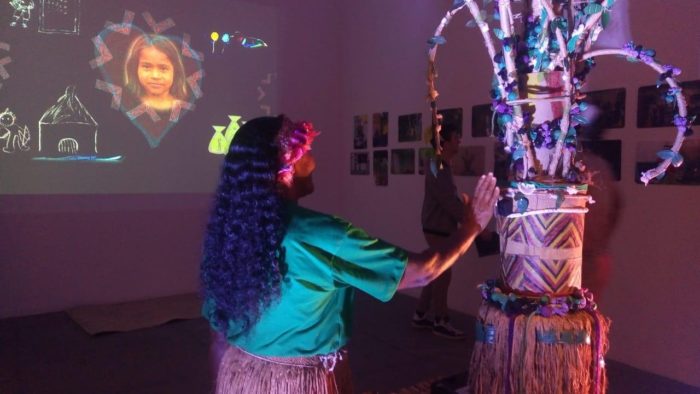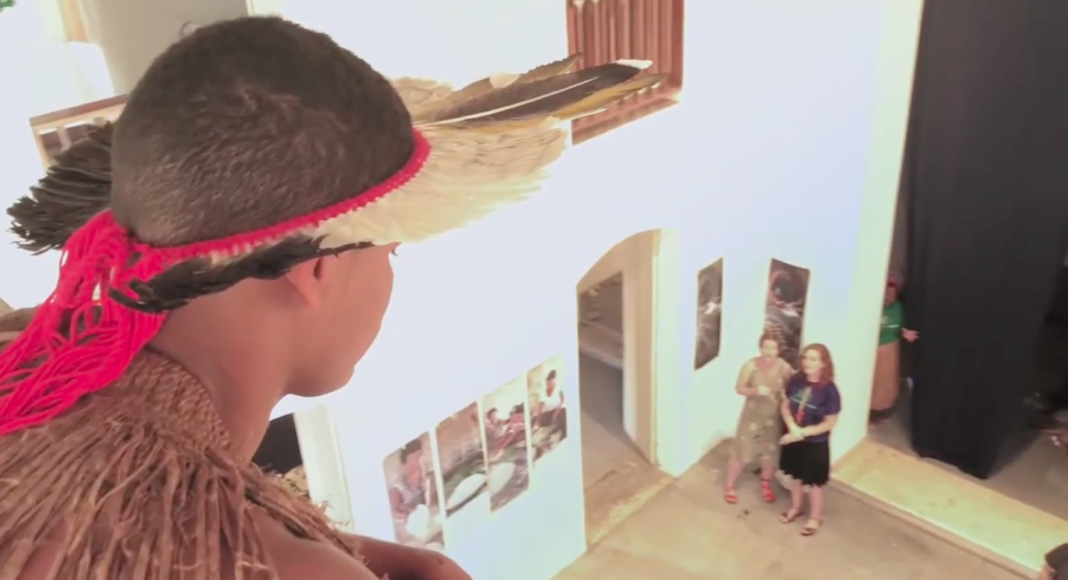Indigenous Artists Occupy Bahia’s Museum of Modern Art
28 July, 2021Indigenous artists staged a ‘retomada’ (reclaiming what is theirs) during an exhibition at Salvador’s Museum of Modern Art of Bahia. They took over the curation, rejecting the separation of ‘high art’ and ‘arts and crafts’, breaking traditional gallery rules and involving family and friends in performance in the museum space. Thea Pitman was there. This article is shared courtesy of S&C partnership with Latin American Bureau and was originally published at https://lab.org.uk/indigenous-artists-occupy-mam/
In 2018, the Bahia-based NGO Thydêwá proposed an art exhibition centred on Indigenous self-representation through electronic art, titled AEI: Arte Eletrônica Indígena. The group is made up of Indigenous and non-Indigenous members who work together to try to lessen prejudices against and create opportunities for Indigenous people in Brazilian society.
Between 2004 and 2014, they gained national and international recognition for their project Índios Online, which facilitated internet access and ‘virtual self-representation’ for a network of Indigenous communities in Northeast Brazil. So, the AEI project was a natural extension of their work in promoting intercultural dialogue and communication technologies among Indigenous people.
The project involved hosting short residencies of mostly non-Indigenous artists in different Indigenous communities in the North East of Brazil, including the Pankararu in Pernambuco, the Kariri-Xocó in Alagoas, the Karapotó Plak-ô in Sergipe and various different Pataxó communities Bahia.
During the residency, 10 works of electronic art were created by the artists, many of which were interactive installations combining hi-and low-tech elements.

The works were taken on tour to the participating communities and later included in a number of European exhibitions. But before this, the they took part in a temporary exhibition at the Museum of Modern Art of Bahia (MAM-BA or MAM) in Salvador in August 2018,
Around twenty Indigenous participants in the project, along with five of the non-Indigenous artists, came to Salvador to exhibit the artworks that they had created together during the opening weekend. This is where the magic happened.
Indigenous Curatorial Agency
While much of the exhibition had been curated by the NGO and the (largely non-Indigenous) project team alongside museum staff, once present in the museum buildings and grounds, the Indigenous participants effectively took over the curation using what Māori scholar Linda Tuhiwai Smith has described as ‘decolonizing methodologies’.
In particular, their strength in numbers allowed them to occupy the space in a kind of temporary, symbolic ‘retomada’ (a reclamation of lands lost during colonisation), and some of them spoke of their presence in the museum in precisely these terms.
For example, Mayá Pataxó Hãhãhãe told me in an interview recorded for the research film Occupy MAM!: ‘I even said to my colleagues, my brothers and sisters, my relatives in the community, I told them that we were getting ready to carry out a “retomada” at the Museum, to show off our knowledge, our experience…’
During the occupation, the Indigenous participants deliberately broke the rules of this conservative ‘white’ art institution to suit themselves – for example, they ate, drank and smoked wherever they pleased in the gallery spaces, and they exhibited and sold handicrafts alongside the electronic artworks, refusing any institutional separation of ‘high art’ for contemplation on the one hand and ‘arts and crafts’ made to ensure economic survival on the other.
They also used their time at the MAM not only to present themselves and their art to the public and increase their visibility in society in positive ways, but also to spend time visiting their relatives in the space and to satisfy their collective desire to celebrate tekó porã/bem viver (‘good living’ in Guarani/Portuguese) together, though their performance of rituals.

Their own curatorial agency is apparent in many of the interviews I conducted during the opening weekend of the exhibition. On the importance of being able to go to the MAM to present their work, Mangtxai Camacam Imboré said, ‘It’s a great experience. I had never set foot in a museum, I didn’t even know what a museum was, I’d just heard them mentioned in passing […] and now I can see for myself. I’m going to take this new experience back to my community with me’.
Equally, Tawanã Kariri-Xocó observed, ‘I felt renewed by this project […] So while I was there I felt it was wonderful to see myself, see my children, my family, my community there, to see my River Opara from the other side, if you see what I mean, on a TV screen’.
Alysson Xokó was emphatic about the importance of the exhibition for facilitating not only intercultural, but also interethnic conversation: ‘The exhibition here at the museum was [..] brilliant, because we were able to share our work with people from other Indigenous communities, with our relatives, and we also got to see the work they did in their villages’, while Yarú Tupinambá emphasised the importance of ritual celebration in the coming together of the otherwise far-flung ethnic groups: ‘so through a project like this […] in a ritual with all of them, you feel a different kind of energy, you feel a joyful atmosphere.’
Such rituals could also be quite explicitly about reclaiming space, as is clear in the spontaneous performance of a ‘toré’ that happened at the end of the opening weekend, as featured in the Occupy MAM! film.
This ‘toré’, known as ‘Caboco índio’, was led by Geovam Pankararu, who adapted the standard lyrics about the right to occupy certain spaces, to the situation of the exhibition. He then proceeded to lead the ever-increasing group of singers and dancers on a tour of the whole exhibition space in a powerful statement of Indigenous cultural revindication and curatorial agency.

Future curation opportunities for Indigenous artists in Brazil
The situation with Indigenous contemporary art and Indigenous-led curation of Indigenous and other types of art has developed quite considerably since the AEI exhibition in 2018. In April 2021, we saw the all-Indigenous curation of an online Indigenous art festival, Rec.Tyty, and there have been several recent events reflecting on the curation of Indigenous art and/or Indigenous curatorial practice.
These are very welcome developments indeed. They also demonstrate how by by taking over the curation at MAM, the Indigenous participants in the AEI exhibition sparked the development of a much-needed Indigenous-led, decolonial art curation practice.
Thea Pitman’s research on this topic will be published on 21 May as Decolonising the Museum: The Curation of Indigenous Contemporary Art in Brazil (Tamesis, 2021): https://boydellandbrewer.com/9781855663480/decolonising-the-museum/.
Follow Sounds and Colours: Facebook / Twitter / Instagram / Mixcloud / Soundcloud / Bandcamp
Subscribe to the Sounds and Colours Newsletter for regular updates, news and competitions bringing the best of Latin American culture direct to your Inbox.

